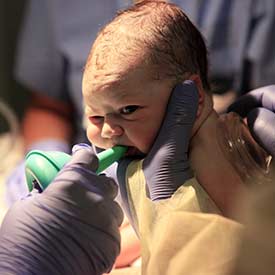$48.5
Million
Truck Accident Case
We took more than 60 depositions in five different states. Because of Stephenson’s tireless advocacy, shortly before the trial was to commence, the defendants settled the case for $48.5 million.
Birth Complications: Brachial Plexus Injuries

The vast majority of births in this country are perfectly normal with good outcomes, producing healthy infants. But sometimes unforeseen complications can arise. Brachial plexus birth injury, sometimes called brachial plexus birth palsy (BPBP), is one possible set of health problems that can occur when the birth process goes awry.
Brachial plexus birth injuries happen more often than you might think: As many as three out of every 1,000 infants end up with some kind of BPBP due to difficulties encountered while the mother gives birth. This group of injuries usually occurs only on one side of the upper body and can affect the function and movement of the shoulder, arm, wrist, and hand. A lack of feeling or numbness in the affected area can also result. BPBP can cause lifelong disability.
The Brachial Plexus and Nerve Damage
The grouping of nerves that enable the shoulder, arm, wrist and hand to communicate with the spinal cord is called the brachial plexus. An injury to this neural network can produce malfunctions in using the muscles in various parts of the limb, depending on which nerves sustain damage. The harm done to this network can create difficulties in lifting, bending, straightening, or lowering the arm. The specific location of the injury and the severity of the trauma to the brachial plexus dictate the type of impairment.
There are four possible kinds of nerve trauma that are common with brachial plexus injuries. From the mildest to the most severe, they are:
- The nerve is damaged from stretching.
- The nerve has healed from a tear, but scar tissue has formed, interrupting the signals that travel along the nerve to the muscles.
- The nerve has torn, but the tear is not where the nerve attaches to the spinal cord.
- The nerve has torn away from the spinal cord.
Damage to the brachial plexus during the birth process can give rise to certain palsies:
- Erb’s palsy. With Erb’s, it is the upper brachial plexus nerves that are injured, producing problems with normal movement of the shoulder and arm.
- Klumpke’s palsy. With Klumpke’s, it is the lower brachial plexus nerves that are injured, producing problems with normal movement of the wrist and hand.
- Global palsy. In global palsy, both the upper and lower sets of nerves sustain trauma. This can result in no movement of the shoulder, arm, or hand, along with a lack of sensation in the affected areas.
Symptoms and Diagnosis of Brachial Plexus Injury
The symptoms of brachial plexus injury arising from the birth process are usually noticed fairly quickly:
- The infant’s upper or lower arm or hand has no movement.
- The affected arm is held against the body, bent at the elbow.
- The Moro reflex (also known as the startle reflex, something that is present only the first few months after birth) on the affected side is absent.
- The infant’s grip on the affected side is weak.
When symptoms are seen, the doctor will examine the infant for movement in the affected arm or hand. The limb may flop if the infant is gently rolled from side to side. If the Moro reflex is not present, X-rays of the collarbone may be ordered, along with special tests such as an electromyogram (EMG) to gauge muscle strength and a nerve conduction study (NCS) to discover how far impulses are traveling along the nerve.
Reasons for Brachial Plexus Nerve Damage
The most normal-appearing birth can go bad quickly, necessitating certain actions on the part of medical personnel. If excessive and extreme force or stretching is used to remove the baby from the mother, brachial plexus injuries can occur. Sometimes excessive force is due to forceps or to vacuum extraction.
Shoulder dystocia, or the baby’s shoulder being “stuck” in the mother’s pelvis, can result in damage to the brachial plexus nerves if the doctor or midwife uses too much force trying to “unstick” the infant’s shoulder. This can happen even if forceps or vacuum extraction is not used.
Other risk factors for brachial plexus birth injury besides shoulder dystocia include:
- An unusually large infant
- Maternal diabetes
- Maternal obesity
- Breech birth (feet first)
- Prolonged labor and the need for quick delivery.
There can be times when a Caesarean section (C-section) is called for, especially when the infant is large or when a C-section is needed to prevent harm to the infant or mother. Sometimes brachial plexus injuries can be considered a result of medical malpractice, if the medical standard dictated that the doctor should have recognized the need for a C-section. If you believe your child’s brachial plexus injury resulted from medical negligence, it’s crucial to consult with an experienced Indiana medical malpractice attorney.
Treating Brachial Plexus Birth Injuries
Physical therapy and gentle massage can sometimes remedy mild cases, such as neuropraxia, where the nerve is stretched but not torn. However, if the problem shows no sign of healing after three to six months, surgery may be needed. More severe cases of brachial plexus birth injury, such as avulsion, usually need surgical repair.
The more serious the damage to the brachial plexus, the more likely it is that problems will be lifelong, resulting in permanent disability. A lifetime of specialized treatment and care for BPBP can reach $1 million. The cost of care for a child with such an injury can drain a family’s resources. When negligence resulting in medical malpractice is present, a lawsuit can provide funds which will ease this burden and guarantee adequate and effective treatment for your child.

 Mike Stephenson has 40 years of experience and is a trusted advisor to many individuals and companies. His current practice is dominated by civil litigation in state and federal courts. He focuses much of his time on handling catastrophic injuries caused by all types of accidents, including motor vehicle, trucking, workplace injuries, product liability, and fire, just to name a few. He also works extensively in construction accidents. [
Mike Stephenson has 40 years of experience and is a trusted advisor to many individuals and companies. His current practice is dominated by civil litigation in state and federal courts. He focuses much of his time on handling catastrophic injuries caused by all types of accidents, including motor vehicle, trucking, workplace injuries, product liability, and fire, just to name a few. He also works extensively in construction accidents. [ 


